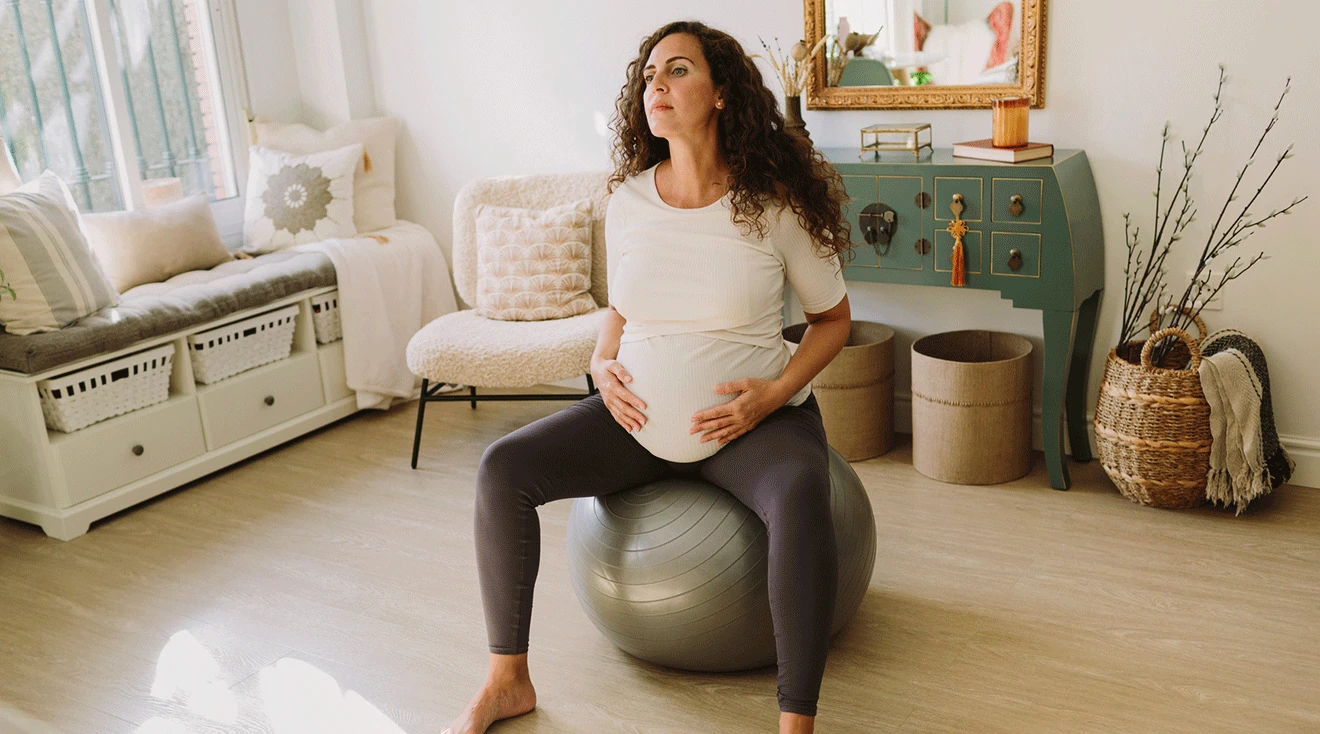How to Use a Birthing Ball in Pregnancy, Labor and Beyond
You might think of bouncing on a birthing ball as a helpful way to speed labor and delivery along. But a birth ball can also offer support all throughout pregnancy, as well as in the postpartum period—after all, it has many benefits, from pain management to core-strengthening to prepping your body for baby’s birth. Read on to learn more about how to use a birthing ball throughout your entire journey.
A birthing ball—sometimes called a pregnancy ball—is a large, inflatable ball that looks a lot like an exercise or yoga ball. Birthing balls have many uses, from keeping you more comfortable during pregnancy to helping rebuild core strength in the postpartum period. And, yes, you can also use it during labor.
“A birthing ball is an incredibly useful tool that can support you through all stages of your pregnancy journey,” says Rita Moore, BSN, RNC-OB, a labor and delivery nurse at Duke University Hospital in Durham, North Carolina. She explains that birthing balls are great for helping expecting parents stay active during pregnancy, for managing pain and aiding in the labor process and for supporting postpartum recovery.
As pregnancy progresses, staying active can become more difficult and the aches and pains of growing a baby will intensify the closer you get to your due date—but a birthing ball can help. For example, it can serve as a more comfortable alternative to a chair. “Unlike a chair, a birthing ball encourages you to sit upright, which can help ease back pain by improving your posture and strengthening your core,” says Victoria Floyd, MSN, CNM, a certified nurse midwife with IU Health Physicians Midwifery in Indianapolis.
Sarah Pollock, MD, an ob-gyn at Atrium Health in Charlotte, North Carolina, says birthing balls can help you prepare your body for labor and delivery. “Bouncing on the ball can help bring baby into the pelvis and help open the pelvis in preparation for delivery,” she explains.
Birthing ball exercises during pregnancy
Whether you’re hoping for some gentle physical activity, pain relief or to prepare for labor, there are a few helpful birthing ball exercises you can perform. Here’s what Floyd, Moore and Pollock suggest:
- Pelvic tilts, side stretches, or rocking your hips side to side while sitting on the ball for safe, low-impact physical activity.
- Sit on the ball and rock back and forth for tailbone pain, or rotate your hips in a circular motion or figure-8 motions to help the pelvis prepare for delivery.
- Simply sit on the ball throughout the day (especially during working hours) to encourage your pelvis into a posterior tilt, which will help baby get into an optimal position for starting labor; sitting on the ball can also help alleviate pelvic pressure.
- Gently bounce on the ball to increase pelvic mobility and reduce tension in your hips and lower back.
- Lean over the ball while on your hands and knees to relieve back pressure.
As wonderful as a birthing ball can be, it’s not enough to physically induce labor. “Realistically, babies and placentas are the deciding factors of when labor will start,” says Moore. Still, the birthing ball is a great tool for helping your body prepare for delivery. “The gentle movements you make on the ball, like rocking or bouncing, can encourage baby to move into the right position, which can help things get going naturally,” explains Floyd, adding, “But don’t worry, sitting or gently bouncing on the ball won’t put you into labor before it’s safe.”
This is where the birthing ball truly shines. While it may not be able to induce labor, it can help manage pain, reduce fatigue and move things along once the body’s already in labor. According to research, a birthing balls is a common natural pain-management tool that nurses and midwives offer to patients who labor without an epidural.
“During labor, a birthing ball can be a lifesaver,” says Floyd. “While it certainly won’t take away the pain and work of labor, it can be incredibly versatile for helping you cope with the pain.” For example, rocking back and forth while sitting on the ball can relieve pain and pressure in your tailbone. You can also use the ball as a prop to find a comfortable position, whether that’s sitting, kneeling or leaning. Floyd also notes that it’s good for helping you stay upright and in an active position when you become too tired to walk or stand.
Just like during pregnancy, gently bouncing on the ball during labor helps open up the pelvis, which encourages baby to continue to move down. In fact, Moore says the birthing ball is a great tool for getting baby into a better position, whether that’s moving further down into the pelvis, or even rotating to relieve the pain in the laboring parent. Additionally, sitting on a birthing ball can have a relaxing effect, which is also helpful in progressing labor. “[Birthing balls] can just be comfortable to sit on, which helps keep the birthing person relaxed, decreasing soft tissue resistance in the pelvis and giving baby a path of lesser resistance as they navigate the pelvis,” she says.
Best birthing ball positions for labor
In many cases, the best birthing ball position for labor depends on what’s comfortable for the person delivering baby, as well as baby’s position. Some of the experts’ go-to positions include:
- Sitting on the ball with feet flat on the floor while rocking/rotating your hips or bouncing
- Kneeling on the floor (or bed) and leaning over the ball and rocking hips. Floyd notes that you can also lunge one foot forward while in this position “to allow for asymmetrical opening of your pelvis,” which can help progress a stalled labor
- Standing and leaning over the ball, which should be placed on the bed, a chair, or a low table, then rock side to side and back and forth
- Squatting while holding onto the ball (or sitting on a smaller birthing ball in a squat position). To do this safely, you’ll need to have stable support behind you
- Lying on your side with a small birthing ball between your knees.
In any of the positions where your feet are on the ground, it’s important to keep your stance wide and pelvic floor relaxed. Grip socks can be very helpful in ensuring you stay stable (and safe).
The benefits of a birthing ball don’t stop once baby’s out of the womb. “After baby arrives, you can use the ball for gentle exercises to rebuild core strength, improve posture and ease any lingering back pain,” says Floyd. She adds that a birthing ball can be a comfortable spot to sit with baby after giving birth, and that the gentle bouncing can help soothe baby. (What a great bonus!)
Pollock says she’s a strong advocate of using a birthing ball postpartum, but she stresses that it’s important to check with your provider before getting back on the ball after delivery. Everyone’s postpartum journey is different, and it’s best to make sure that using the birthing ball won’t negatively affect your recovery in any way.
There are a ton of birthing balls on the market. But while most of them look alike, they’re not necessarily made the same way. When researching your options, Pollock, Floyd and Moore say there are a few important factors to consider:
- Size. Finding the right size birthing ball is incredibly important because it affects your positioning when sitting on the ball, and positioning is key when using the ball during labor. (See below for more information on finding the right size.)
- Materials. The best birthing balls are made with sturdy, textured, non-slip materials to ensure the birthing person stays safe while using the ball. Additionally, if you plan on using the ball in the shower while laboring, keep this in mind during your research (check with your birthing center, too, they may already have a shower-safe option for you to use).
- Quality. Pollock notes that a birthing ball that is pressure-tested for up to or over 500 pounds is considered safe for pregnancy. Also, Floyd recommends looking for a ball that includes a pump for easy inflation and deflation.
How to find the right size birthing ball for your needs
Birthing balls are usually measured in centimeters, and the right size will be based on your height. If you’re shopping for a birthing ball and wondering how to find the right size, Floyd suggests:
- 55-centimeter ball for anyone under 5’4”
- 65-centimeter ball for anyone between 5’4” and 5’10”
- 75-centimeter ball for anyone over 5’10”
According to Moore, “When sitting on a birthing ball, your hips and knees should be either even (at about a 90-degree angle) or the knees should be slightly lower than the hips (around a 95-degree angle).” This positioning is ideal for both mobility and safety. “A ball that’s too big will be less stable; a ball that’s too small will strain your knees and create more tension in your low back,” says Floyd.
Moore stresses the importance of finding out what works best for you during pregnancy, labor and postpartum, even if it’s not a birthing ball. “I strongly encourage people to do what feels comfortable and is safe for their own specific physical and mental health needs,” she says. So talk to your provider and test out a birthing ball to see if it’s something that will benefit you during your journey.
Please note: The Bump and the materials and information it contains are not intended to, and do not constitute, medical or other health advice or diagnosis and should not be used as such. You should always consult with a qualified physician or health professional about your specific circumstances.
Plus, more from The Bump:
Victoria Floyd, MSN, CNM, is a certified nurse midwife with IU Health Physicians Midwifery in Indianapolis. She has been supporting birthing people in home, birth centers and hospital settings for 11 years.
Rita Moore, BSN, RNC-OB, is a labor and delivery nurse at Duke University Hospital in Durham, North Carolina. She’s been a labor and delivery nurse for five years, and spent the five years prior to that working with home birth clients.
Sarah Pollock, MD, is an ob-gyn at Atrium Health Women’s Care Eastover in Charlotte, North Carolina. She earned her medical degree from Tulane University and completed her residency at Memorial Health University Medical Center in Savannah, Georgia.
Cleveland Clinic, Benefits of Using a Yoga Ball During Pregnancy and Labor, May 2023
American Journal of Obstetrics & Gynecology, Birthing Balls to Decrease Labor Pain and Peanut Balls to Decrease Length of Labor: What Is the Evidence?, May 2023
Journal of Perinatal Education, Reducing Length of Labor and Cesarean Surgery Rate Using a Peanut Ball for Women Laboring With an Epidural, 2015
Learn how we ensure the accuracy of our content through our editorial and medical review process.
Navigate forward to interact with the calendar and select a date. Press the question mark key to get the keyboard shortcuts for changing dates.





















































